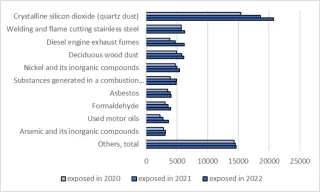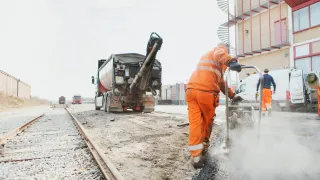Finnish Institute of Occupational Health news 1 March 2024
Employers have reported an increasing number of employees in the ASA register, the Finnish register of workers exposed to carcinogenic substances and processes.
About 51,700 exposed employees were reported in 2022, which is about 3,600 more than in 2021.
The definition of carcinogens changed in 2020 when the ASA legislation (452/2020) was amended. New substances and work methods became subject to reporting with this amendment.
New agents to be reported include, for example, formaldehyde and cobalt and its compounds. New working methods added with the amendment include tasks that involve exposure to crystalline silicon dioxide dust, i.e. primarily quartz dust, substances generated in a combustion process, used motor oils and diesel engine exhaust fumes.
In addition, the working method regarding wood dust exposure now applies to all hardwood dust, i.e. deciduous wood dust. Stainless steel welders must be reported as workers exposed to the working method instead of individual substances. Workers exposed to cytostatic agents must be reported as exposed to the working method, as it covers all the individual compounds used.
40% of exposure reports concern quartz dust
The reports are made by work unit. The employer may define the size and extent of the work unit, but each unit must primarily consist of workers working in a similar work environment with similar method of exposure. Approximately 2,500 work units were reported to the ASA register in 2022. Since 2020, the number of work units has risen by about 200 units per year.
In 2022, approximately 20,700 workers were reported to have been exposed to crystalline silicon dioxide, i.e. primarily quartz dust, which accounts for 40 per cent of all workers recorded in the ASA register. Nearly 800 work units were reported as exposed to quartz.
About 6,300 workers were exposed to stainless steel welding fumes, while approximately 6,200 were exposed to diesel engine exhaust fumes and nearly 6,100 to deciduous wood dust. There were approximately 5,500 workers exposed to nickel and 4,900 workers exposed to substances generated in a combustion process. A similar number of workers were exposed to asbestos and formaldehyde, about 4,000. Approximately 3,600 people were exposed to used motor oils.

Construction industry, machinery installations and repairs and stainless steel welding major industrial sectors
By occupation, the majority of exposures affected about 3,100 people in the agricultural and industrial machinery technicians and repairers, where the total number of individual exposures was about 6,000. Many of these workers were simultaneously exposed to several substances, such as stainless steel welding fumes, diesel engine exhaust fumes, quartz, nickel compounds, used motor oils, deciduous wood dust, asbestos, arsenic and formaldehyde.
The largest profession group exposed to a single substance was building construction workers, where about 3,000 reports related to exposure to quartz were submitted. Approximately 2,800 reports regarding the exposure to stainless steel welding and oxygen cutting fumes of welders and oxygen cutters were submitted.
By industrial sector, the most exposure reports, about 5,700 were submitted from the residential and other building construction sector, where exposure to quartz, deciduous wood dust, asbestos and stainless steel welding fumes were common, for instance.
Submit the ASA report
- ASA reports must be submitted annually in the digital ASA report system: Submit the ASA report online (in Finnish or in Swedish).
- The report for the past year must be submitted by March 31.
- The website also includes a guide and instructional video on how to submit the report.
- If a work unit is no longer obliged to submit a report, this must be notified to the Finnish Institute of Occupational Health by sending a message to asa [at] ttl.fi.
For more information, please contact:
- Sanni Uuksulainen, Senior Specialist, Finnish Institute of Occupational Health, Sanni.Uuksulainen [at] ttl.fi, p. +358 (0)46 850 5132





